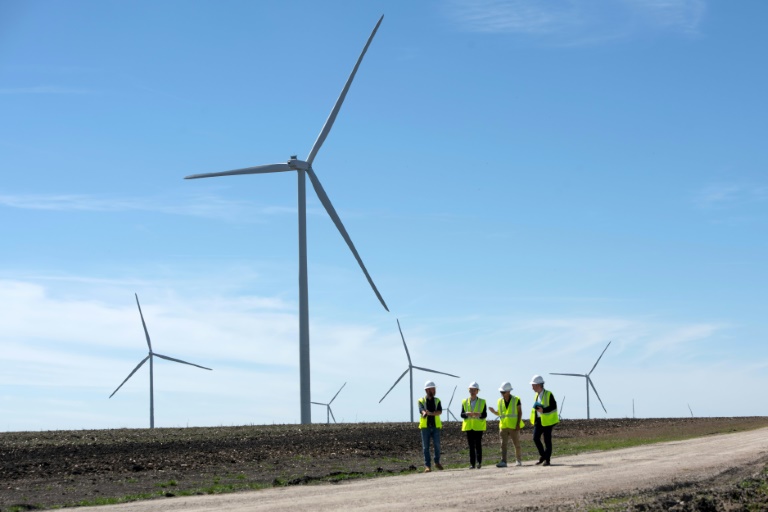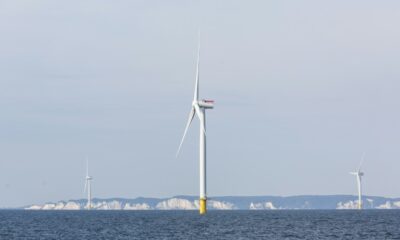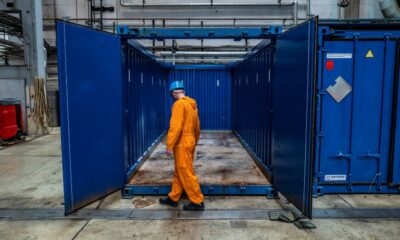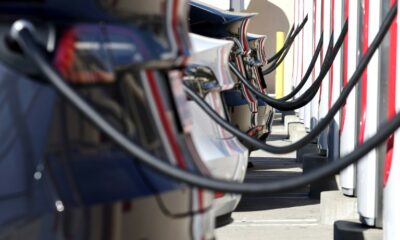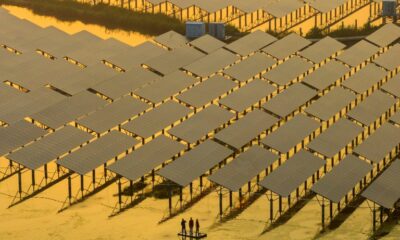Modern Texas was built on oil, and its production has long been a source of immense pride. But now, areas that moved to the steady rhythm of oil derricks for more than a century are making the state a national leader in wind and solar energy.
A convergence of factors has led to this unexpected result: favorable weather (lots of wind and sun), relatively cheap land, the lure of federal clean-energy subsidies, and a desire to backstop a utility system that failed dramatically during a 2021 cold snap.
Two counties south of Dallas, Navarro and Limestone, symbolize this surprising shift. Inextricably part of the Texas petroleum industry since the late 19th century, they are now in the vanguard of the renewable revolution.
Wind and solar projects “have Navarro County leading the nation with renewables,” said the county’s economic development director, John Boswell.
Symbolizing this push is a new wind farm inaugurated last week by French multinational energy company Engie, with 88 wind turbines capable of producing 300 megawatts (MW) of power.
A half-hour’s drive to the west, in the small town of Abbott, is a 250 MW solar farm, also built by Engie, that is now producing electricity.
Texas is the nation’s leader — by far — in providing clean energy to corporate and industrial buyers, at 35 percent of the national total, according to the American Clean Power organization.
The state of Ohio has about half Texas’s number of corporate and industrial projects, just ahead of California in third place.
“It’s true that when we think about Texas, we think about this very large oil and gas state,” said Engie executive Frank Demaille.
But, he added, its natural resources are not all buried in the ground.
“They’ve got lots of wind, lots of sun, and are very good at managing all their different resources.”
– Plentiful resources –
With its huge and sprawling petrochemical industry, a population of 30 million, and a fierce history of independence, Texas in many ways stands apart from the rest of the country — for better or for worse.
One way its go-it-alone mentality did not help became apparent in 2021, when a rare and intense cold wave swept through the state — whose power utility was not connected to two major national grids — provoking electric outages that affected millions and were blamed for more than 200 deaths.
Texas today remains primarily dependent on fossil fuels. As of early this year, gas was its leading source of energy (at 42 percent, according to Ercot, which manages the state’s electrical grid). Coal trails at 11 percent.
But renewable sources have carved out a major role.
Wind-generated power now provides 29 percent of Texas’s needs, with solar at 11 percent. The remainder comes from nuclear and hydropower.
By comparison, wind was at 24 percent just two years ago, and solar at less than 5 percent.
Given Texas’s deep investments in and long history with carbon-based energy, experts don’t expect it to give way to renewables anytime soon.
“I think what you’ll see in the future is a combination of both of those, because Texas is committed to both” sources, said Jeff Montgomery, whose Blattner Energy company is behind 400 renewable projects across the country.
Texas is a major supplier of natural gas to Europe. And now, said Demaille of Engie, “because of the war in Ukraine, we’re importing more gas from the US, and especially from Texas.”
Meantime, however, legislation backed by the Biden administration and voted into law last year could accelerate the move to renewables through substantial federal subsidies.
– ‘Show the value’ –
Robert Lowry, superintendent of the Coolidge school district in Limestone County, said the tax revenues that renewable-energy projects generate can make a difference for school systems like his.
“We have the funds now to be able to do some great things for our kiddos that we’ve ever had before,” he said.
But not everyone shares that enthusiasm.
John Null, an engineer who lives near Dawson, said locals aren’t seeing the immediate benefit they would hope for from the huge wind turbines visible from his window.
During an ice storm last month, for example, the turbines kept turning but, linked to a broader network, provided no energy to the neighboring community.
He said wind power needs to be “properly pitched” to the public.
“Show me the value,” he said, and people would support wind energy.
In some areas, renewable projects are touted as providing power to poorer neighborhoods.
In a less-affluent part of Houston, the fourth-largest US city, a solar farm is to be built over a former dump. That project should begin providing 50 MW of power in 2024, said BQ Energy CEO Paul Curran.
A former petroleum industry executive, Curran says fossil fuels and renewable energy sources need not be in competition.
“It’s not very difficult if you do wind and solar in the right places for the right market,” he said.
“It’s very well received by energy experts and oil industry people.”

 Business5 months ago
Business5 months ago
 Business4 months ago
Business4 months ago
 People4 months ago
People4 months ago
 Events6 months ago
Events6 months ago
 Events3 months ago
Events3 months ago
